Kanagawa Prefectural Museum of Cultural History
(We are closed until September 2026.)
- ホーム
- Kanagawa Prefectural Museum of Cultural History
(We are closed until September 2026.)
Kanagawa Prefectural Museum of Cultural History
(We are closed until September 2026.)
Information for Visitors
During Your Visit
- Photography or video are not allowed in the special exhibition room. In the other rooms, the museum reserves the right to treat permits.
- No photography is allowed regarding to any objects indicated by the No photography sign.
- In order to protect the cultural property or as it may disrupt other visitors, flashlights, additional lighting, tripods, monopods and selfie sticks are not allowed.
- On using camera devices with sounds such as mobile phones, please make sure not to disturb other visitors. - Please do not bring in umbrellas. Please use the umbrella stand.
- Parking lot use is restricted to visitors with disabilities and tour group buses.
- You can enjoy beverages at drink corner. Food and beverages are not allowed in the exhibition rooms and the library.
- No smoking on the premises.
Hours
- 9:30a.m. to 5:00p.m. (last admission at 4:30p.m.)
Closed
- Mondays (except for national holiday on Monday)
- Year-end/New Year holidays (December 28 to January 4), and occasionally to reorganize exhibits.
- The museum may also temporarily close at other times. Please visit our website, etc., for further information.
Admission Fee
| Permanent Exhibition |
20yrs. and older: \300 (\250) |
|---|---|
| Special Exhibition | The separate fee is charged for special exhibitions. |
Free Audio Guide : POCKET CURATOR
“POCKET CURATOR” is the free application which provides the information about the permanent exhibition with audio, text and images. It can be used with iOS and Android devices(smartphone, tablet, etc.). An internet connection is required to view these pages.
Download “POCKET CURATOR” from here.(Developer's Site).
How to use
1 Connect to the internet. (Please do not connect to our Free Wi-Fi until the installation is finished.)
2 Install the app.
3 Select English.
4 Select Kanagawa Prefectural Museum of Cultural History.
- We recommend that you install this apprication before visiting us.
Access
- By train
- A one-minute walk from exit 5 of Bashamichi Station on the Minatomirai Line
- A five-minute walk from exit 9 of Kannai Station on the Yokohama municipal subway (Blue Line)
- An eight-minute walk from Sakuragicho Station or Kannai Station on JR lines
- By car
- A five-minute drive from the Minato-Mirai exit ramp of the Metropolitan Expressway (Shuto Expressway) Yokohane Line

Permanent Exhibitions
Theme 1: Those who Lived in Ancient Sagami Area
The Kanagawa prefecture area blessed with a warm climate and abundant natural is including many sites such as settlement, shell midden, cave site, tumulus (Kofun), tunnel tomb (Yokoana-bo), and temple. The present-day Kanagawa prefecture area covers ancient Sagami province and part of Musashi province.
This exhibition introduce a life of people of prehistoric period and ancient period (Namely, pal eolithic period, Jomon period, Yayoi period, Kofun period, Nara period, Heian period) with the use of artifact from various places within Kanagawa-prefecture or models of reconstructed sites.
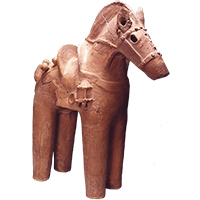
Burial mound figurine in the shape of horse
(The Kofun period)
Pottery in the form of a human face
(The Jomon period)
Theme 2: Urban Kamakura and the People of Medieval Times
Displays of various materials portray the many facets of the history and culture of eastern Japan in medieval times, focusing on transitions in the samurai governments during the four centuries that began with Minamoto no-Yoritomo's establishment of the Kamakura shogunate. They portray the rise of the Kamakura government following the Shogunate's downfall and up to the collapse of the latter-period Hojo clan that held sway over the Kanto region from its Odawara base during the Warring States era. Aspects of common people's lives are seen through items excavated in downtown Kamakura; interaction with faraway China; and the Zen, Jodo sects, and Nichiren Buddhist sect that attracted fervent beliefーjust some of the various topics the exhibition covers.
Works of art and crafts itemsーincluding pottery, lacquerware carved in the Kamakura style, ink paintings, sculptures of Buddhist images, and stoneworkーare also displayed in abundance in each section. A room in the style of the Middle Ages has also been reproduced that includes a life-size reconstruction of Engaku-ji temple's reliquary hall.

Attributed to Minamoto-no Yoritomo
(Reproduction)
Theme 3: The Highways and Popular Culture of Early Modern Times
The Kanagawa Prefecture region bordered the metropolis of Edo in the early modern era. The Koshu-Kaido highway connected Edo with the Koshu and Shinshu regions, crossing the edge of the northern region, and the Tokaido highway linking Edo and the Kyoto region passed through the southern section. Of the two, the Tokaido highway was a main trunk line that passed through castle towns, inn towns, and checkpoints, with famous and historical sites that included sacred Mount Oyama, Kanazawa Hakkei, Enoshima island, and Kamakura, as well as Hakone's hot springs spas in the vicinity of the highway. We can see diverse local characteristics from these.
Related exhibits include old documents, paintings, maps, ukiyo-e prints, and models, providing an introduction to what characterized early modern Kanagawa, including how the highways appeared, the prosperity that sprang from commoners' religious beliefs and pilgrimages to famous places, the villages and people that sustained the highways, and the commodities that sustained life in Edo.

"Hodogaya on the Tokaido," from Fugaku Sanjurokkei (Thirty-six views of Mount Fuji) by Katsushika Hokusai
Theme 4: Modernization and the Opening of Yokohama's Port
Reference materials provide insights into distinctive aspects of Kanagawa's modernization, such as interchanges with foreign countries under "the national seclusion," Commodore Matthew Perry arrival in Japan, opening the treaty port of Yokohama to the rest of the world, westernization throughout the area of Kanagawa Prefecture, the civil rights and freedom movement, and the development of various modern industries.
There are also exhibits of ukiyo-e prints depicting Yokohama scenes, modern paintings, newspapers, old photographs, and other materials related to Yokohama's culture and customs during that time.
Furthermore, now designated as an important cultural treasure and national historic site, the Yokohama Specie Bank main branch buildingーwhich was completed in 1904 and has been converted for use as the Kanagawa Prefectural Museum of Cultural Historyーis featured extensively in exhibits of reference materials.
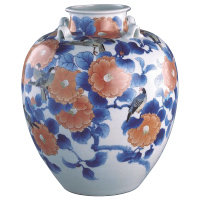
Vase with camellia and Java sparrow pattern by Miyagawa Kozan
(Makuzu ware)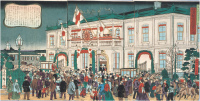
Yokohama Yubinkyoku Kaigyo no Zu (Opening of Yokohama Post Office) by Utagawa Hiroshige III
Theme 5: Contemporary Kanagawa and Traditional Culture
Exhibits show how changes in Kanagawa Prefectureーfrom the Great Kanto Earthquake and subsequent reconstruction, socioeconomic upheavals in the wake of the Showa era depression, military facilities during the 15 years of war, postwar reconstruction and the impact of Occupation policies all the way up to the economic boom eraーaffected the lifestyles of Kanagawa residents.
The implements and modes of everyday life passed down from parent to child and child to grandchild underwent modernization from the mid-1950s, and traditional culture began to fade away. Additional exhibits of materialsーincluding tools from various professions and materials related to religious beliefsーare meant to encourage visitors to ponder our former lifestyle culture deeply.
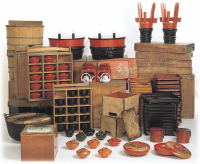
Low dining table set shared in a village
Collection Exhibitions
The museum displays various items gathered for its collection. No admission is charged to view the gallery, which is located in the free access section on the first floor of the museum.
Free Access Sections

Library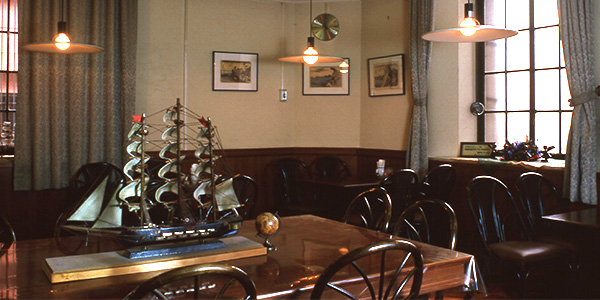
Coffee Shop Tomoshibi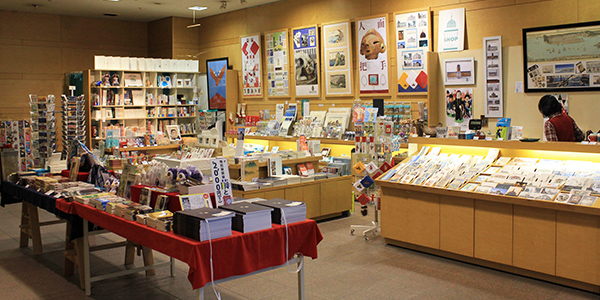
Shop

